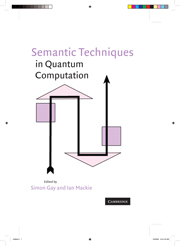Book contents
- Frontmatter
- Contents
- Contributors
- Preface
- 1 No-Cloning in Categorical Quantum Mechanics
- 2 Classical and Quantum Structuralism
- 3 Generalized Proof-Nets for Compact Categories with Biproducts
- 4 Quantum Lambda Calculus
- 5 The Quantum IO Monad
- 6 Abstract Interpretation Techniques for Quantum Computation
- 7 Extended Measurement Calculus
- 8 Predicate Transformer Semantics of Quantum Programs
- 9 The Structure of Partial Isometries
- 10 Temporal Logics for Reasoning about Quantum Systems
- 11 Specification and Verification of Quantum Protocols
- Index
- References
8 - Predicate Transformer Semantics of Quantum Programs
Published online by Cambridge University Press: 05 July 2014
- Frontmatter
- Contents
- Contributors
- Preface
- 1 No-Cloning in Categorical Quantum Mechanics
- 2 Classical and Quantum Structuralism
- 3 Generalized Proof-Nets for Compact Categories with Biproducts
- 4 Quantum Lambda Calculus
- 5 The Quantum IO Monad
- 6 Abstract Interpretation Techniques for Quantum Computation
- 7 Extended Measurement Calculus
- 8 Predicate Transformer Semantics of Quantum Programs
- 9 The Structure of Partial Isometries
- 10 Temporal Logics for Reasoning about Quantum Systems
- 11 Specification and Verification of Quantum Protocols
- Index
- References
Summary
Abstract
This chapter presents a systematic exposition of predicate transformer semantics for quantum programs. It is divided into two parts: The first part reviews the state transformer (forward) semantics of quantum programs according to Selinger's suggestion of representing quantum programs by superoperators and elucidates D'Hondt-Panangaden's theory of quantum weakest preconditions in detail. In the second part, we develop a quite complete predicate transformer semantics of quantum programs based on Birkhoff-von Neumann quantum logic by considering only quantum predicates expressed by projection operators. In particular, the universal conjunctivity and termination law of quantum programs are proved, and Hoare's induction rule is established in the quantum setting.
8.1 Introduction
In the mid-1990s Shor and Grover discovered, respectively, the famous quantum factoring and searching algorithms. Their discoveries indicated that in principle quantum computers offer a way to accomplish certain computational tasks much more efficiently than classical computers, and thus stimulated an intensive investigation in quantum computation. Since then a substantial effort has been made to develop the theory of quantum computation, to find new quantum algorithms, and to exploit the physical techniques needed in building functional quantum computers, including in particular fault tolerance techniques.
Currently, quantum algorithms are expressed mainly at the very low level of quantum circuits. In the history of classical computation, however, it was realized long time ago that programming languages provide a technique that allows us to think about a problem that we intend to solve in a high-level, conceptual way, rather than the details of implementation.
- Type
- Chapter
- Information
- Semantic Techniques in Quantum Computation , pp. 311 - 360Publisher: Cambridge University PressPrint publication year: 2009
References
- 7
- Cited by



